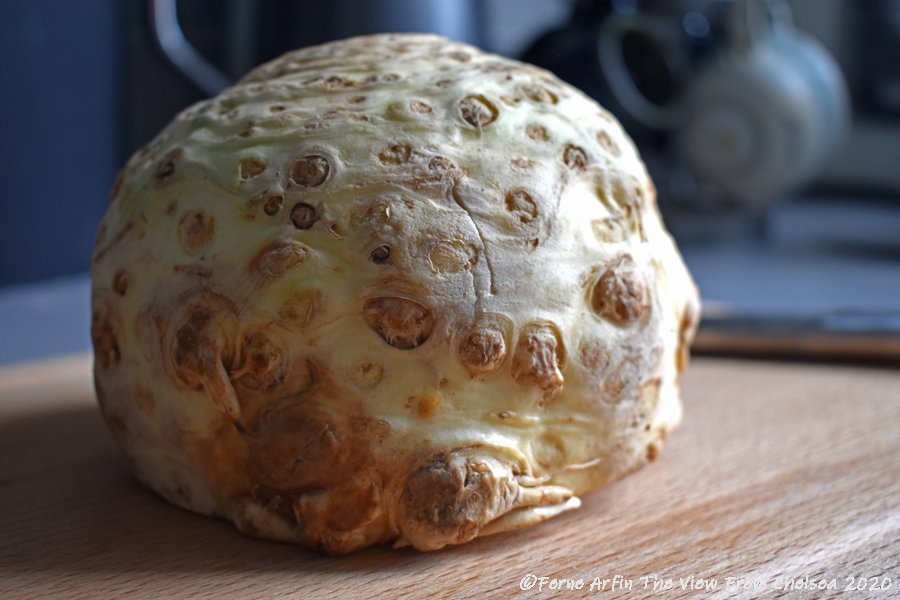 by Ferne Arfin 22 July 2020
by Ferne Arfin 22 July 2020
A taste of France: Beautiful ways with ugly vegetables
If the pandemic is keeping you from long haul travel this summer, you can at least bring a taste of faraway destinations to your table by preparing some of their dishes. This French way with ugly vegetables is the first of what I hope will be an occasional series of evocative dishes from European destinations that are easy to make in your own kitchen.
If Europe is off the radar in this summer of COVID-19 (and if you are thinking about travelling from the USA, let’s face it, it is) with the right special effects, you can still travel in your imagination. Dim the lights and light a few candles, download some vintage Parisian jazz, crack open a bottle of vin rouge ordinaire and whip up some crudités and an omelette fine herbs and Voilà! you’re in a Paris bistro.
Well almost. Work with me here.
The good news is that you don’t have to agonize over Master Chef recipes or dust off your mother’s volume of Julia Child’s Mastering the Art of French Cooking. You don’t even have to spend hours of preparation. The food that most French people eat every day is not impossible for the average home cook to prepare.
They also often make delicious and beautiful presentations of the kinds of ugly ingredients (like the monster pictured above – more about it later) many of us, at best, throw into the soup pot or, at worst, simply discard.
Turning ugly vegetables into hors d’oeuvres
When you see crudites as an hors d’oeuvre or first course on a French menu, you might anticipate sticks of raw carrots, cucumbers and celery with something to dip them in. And you might, in fact, get that. But what if the best priced carrots at the market that day were big and woody or peculiarly misshapen.
French cooks are thrifty and there is almost nothing that diners won’t eat if properly and carefully prepared. If you’ve ever looked askance at a plate of frogs legs or brains in black butter, you know this is true. Fortunately, ugly vegetables are less of a challenge to both the cook and the diner.
These grated vegetable salads, for example, are virtually national dishes. You won’t find recipes for them in haute cuisine cookbooks. But they are virtually omnipresent; found everywhere from the home kitchen to the Parisian bistro. Delis and traiteurs (shops that sell prepared dishes to heat up or finish at home) sell them by the kilo to take away. Even supermarkets have them in plastic packets for desk lunches (yes, these days even the French sometimes lunch at work). And there’s not a home cook alive who can’t produce a decent version.
So let’s get started.
Carrottes Râpées
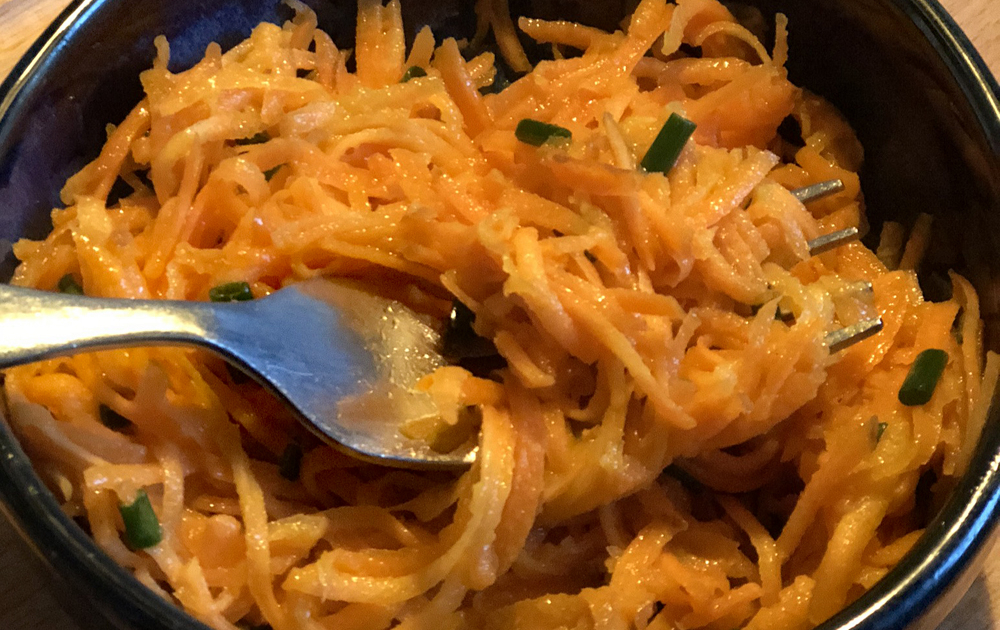
Salade de Carrottes Râpées sounds so mundane when you call it grated carrot salad but that’s what it is. And if by mundane you mean everyday, it is that too. But the way the French make it, it is anything but ordinary. This terrific and popular way to use big, old or misshapen carrots is succulent, crunchy, refreshing and very easy to make.
The coarse texture of the carrots is important so use the coarsest grater you have, the julienne blade on your food processor, or a great little French tool commonly called a “mouli julienne” (scroll down to find out what that is and where to get one).
This recipe serves five or six as a side dish, three or four as the main component of a meal. It will keep in the refrigerator two days. After that it becomes soggy. But it is so delicious, I challenge you to keep it around that long anyway.
Ingredients of carrottes râpées
- 1 pound of large carrots
- 1/2 to 1 tsp dijon mustard (optional)
- 1 tsp of sugar or honey (optional)
- juice and zest of one whole, unwaxed lemon
- 1/4 cup mild olive oil or salad oil
- 1/2 tsp sea salt or kosher salt
- a few tablespoons of snipped, mild herbs – use chives or flat-leaved parsley (avoid stronger herbs that might overpower the sweetness of the carrots)
- optional extras (see Method)
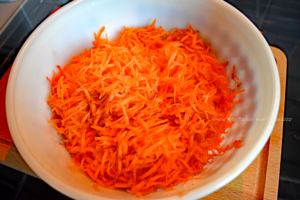
Method for carrottes râpées
- Wash and scrape or peel the carrots. If the carrots are organic, you don’t have to peel them but for aesthetic reasons, I prefer peeled carrots.
- Grate or julienne the carrots and set aside in a large bowl.
- Make the dressing – Combine lemon juice and zest with mild olive oil. Extra virgin olive oil. It is too strongly flavoured and will overpower the sweetness of the carrots. Beat in salt, mustard (optional) and sugar if needed. If the carrots are naturally sweet, you may not want to add any sugar.
- Chop parsley or snip chives into quarter-inch pieces.
- Pour dressing and herbs over the carrots and toss thoroughly.
- Adjust seasoning
- This salad can be eaten immediately but it’s better if refrigerated for at least 30 minutes.
- Adding optional ingredients – some cooks like to toss in one of the following: plumped raisins, pine nuts, sesame seeds, grated ginger or garlic. I’d avoid adding extras. The less you mess with this salad the better.
Celeri-rave Remoulade
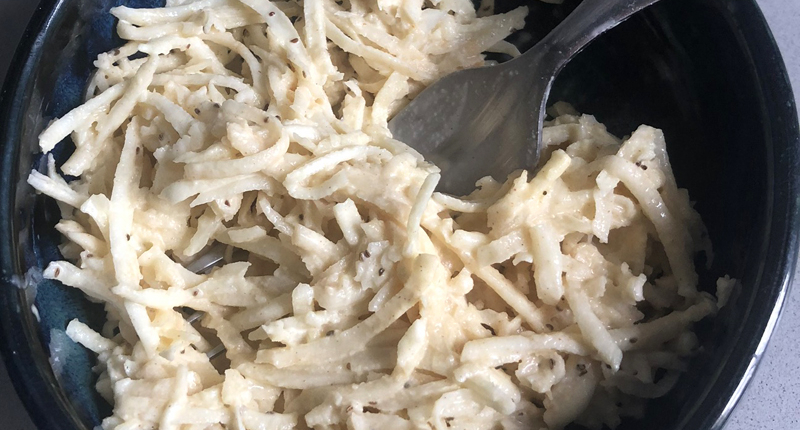
The knobbly, cream and brown globe at the top of this post may look like an alien or a mummified version of Donovan’s Brain but it is, in fact, celeriac or celery root (celeri-rave in French). It’s a versatile root vegetable that can be baked, roasted or mashed. But the very best way to prepare this ugly vegetable is raw and tossed in a mayonnaise-based sauce known as a remoulade.
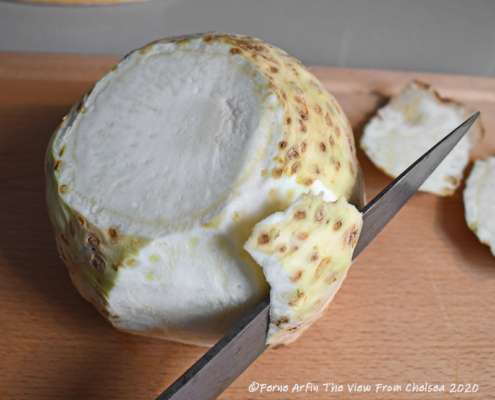 Along with the carrot recipe above, this turns up among the crudités in cafés, and deli/traiteurs, as well as home kitchens, all over France. It’s very easy to make but you will need a sharp kitchen knife. The hardest part of this recipe is peeling and cutting up the celeriac. Traditionally it is cut in julienne, no larger than matchsticks. Larger strips are easier to cut and possibly last longer in the refrigerator but they change the quality of the salad. Fortunately, you don’t need Cordon Bleu skills. Use the largest grating attachment on your food processor or invest in the mouli-julienne described at the end of this post.
Along with the carrot recipe above, this turns up among the crudités in cafés, and deli/traiteurs, as well as home kitchens, all over France. It’s very easy to make but you will need a sharp kitchen knife. The hardest part of this recipe is peeling and cutting up the celeriac. Traditionally it is cut in julienne, no larger than matchsticks. Larger strips are easier to cut and possibly last longer in the refrigerator but they change the quality of the salad. Fortunately, you don’t need Cordon Bleu skills. Use the largest grating attachment on your food processor or invest in the mouli-julienne described at the end of this post.
The recipe serves four to six as a side dish.
Ingredients for celeri-rave remoulade
- 1 medium-sized celeriac, about 1 3/4 pounds
- juice of half a lemon
- 5 tbsp good quality mayonnaise
- 3 tbsp smooth Dijon mustard
- pinch of sea salt
- freshly cracked black pepper to taste
- celery seed (optional)
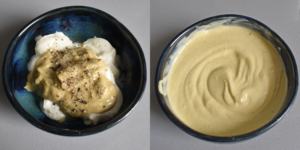
Method for celeri-rave remoulade
- Peel celeriac and cut in matchstick julienne
- Toss with lemon juice – this vegetable discolours quickly and you want to keep it as white as possible
- Blend mustard, mayonnaise and freshly cracked black pepper into a smooth sauce.
- Pour the sauce over the celeriac and toss to coat thoroughly.
- Season to taste
- At this point, I like to sprinkle on some celery seed. It’s not in the purists’ version but I think it enhances the celery taste. If you can’t find celery seed don’t worry, the dish is fine without it. Do not, whatever you do, substitute celery salt. In the UK, the Bristol-based Bart brand, found in some supermarkets, packages it.
- Refridgerate at least an hour to blend flavours.
And a tool to turn ugly vegetables into beauties
Moulinex, the French appliance and kitchen gadget company, have a little tool that makes creating these salads fast and easy. It’s called a Moulinex Julienne Mill though most people call it a mouli-julienne. It’s not electric and it’s small enough to fold up and tuck away in a drawer. To use it, you choose and install a blade, insert the hand crank, fill the hopper with chunks your chosen food and turn the crank to create little mountains of julienned vegetables.
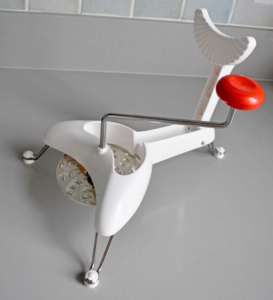
Assembled mouli-julienne
I’ve had one for a while and what I like about it is that it is much easier to clean and put away than my electric food processor. You just take it apart and then dump the whole thing in the kitchen sink. How many times have you had second thoughts about making something because of the fuss involved with a food processor? And it doesn’t take up any valuable kitchen counter real estate when not in use.
You can buy one, like the version in these pictures, from Amazon with this link. In the interests of full disclosure, if you do click on the link and buy the product I will receive a small payment that helps support this blog, at no extra cost to you. I never suggest products unless I’ve tried them and can honestly recommend them. I do use my mouli-julienne often. The only complaint about the product I have is that, when I first learned to use one of these, it used to be made of metal. The one now available is made of plastic, except for the crank and rotary blades and seems a bit flimsier. That said, it still does the job.
Classic French Omelet to complete the meal
A French omelet turns the dishes in this culinary travel preview into a hearty lunch or light, weeknight supper à la française. Mastering the perfect classic French omelet is a skill that cannot be explained simply using words. Fortunately, American-based, French chef Jacques Pépin’s famous omelet video shows you everything you need to know.
More European recipes to try:
Like this post? Please pin to share or read later
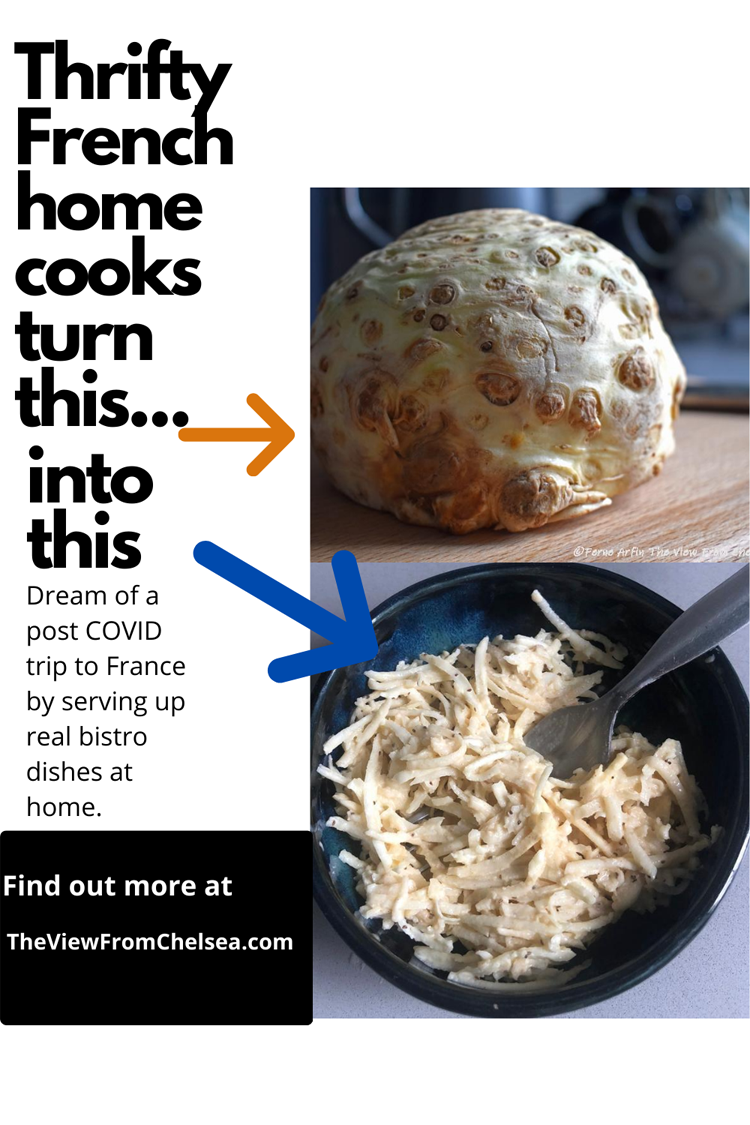
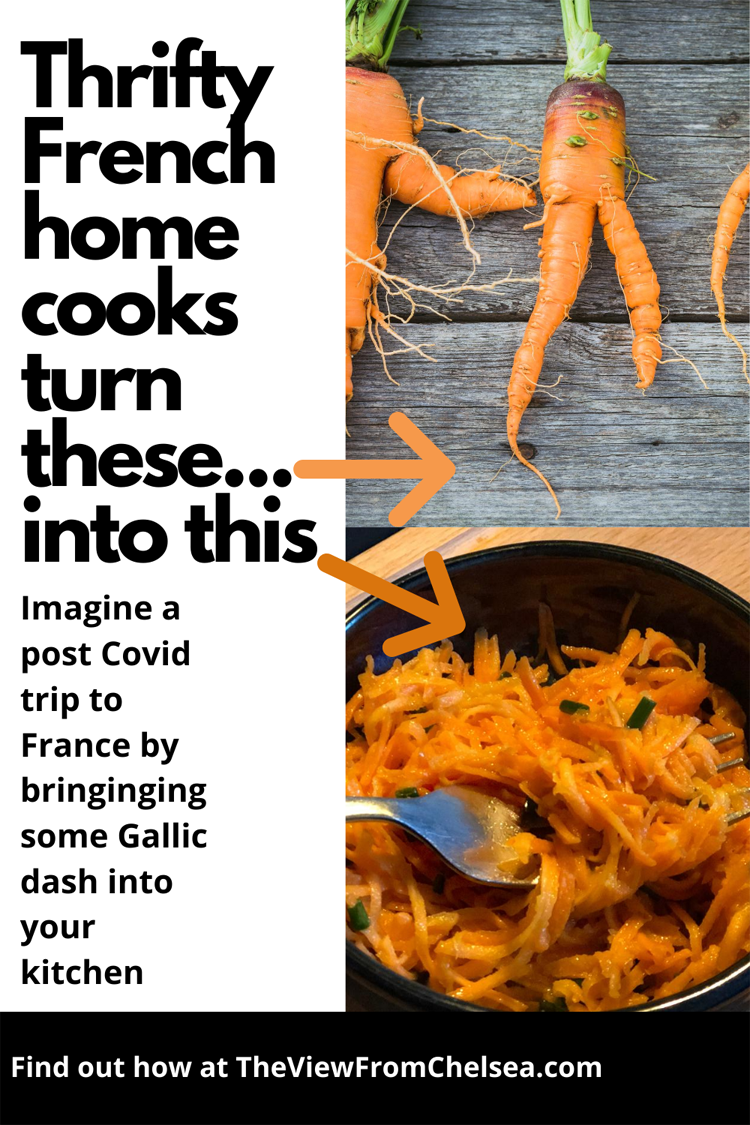


 Ferne Arfin 2017
Ferne Arfin 2017 Ferne Arfin 2020
Ferne Arfin 2020
Trackbacks & Pingbacks
[…] Ugly vegetables the French way […]
Leave a Comment
What do you think?Please add your comments and suggestions here.